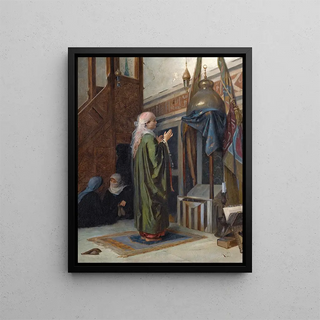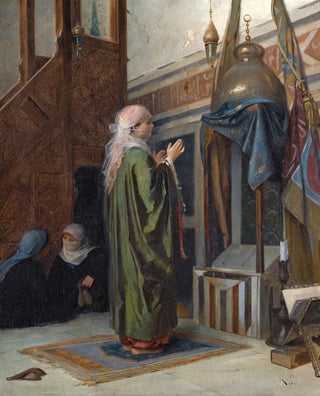Art print | In the mosque - Theodoros Ralli


View from behind

Frame (optional)
In the fascinating world of art, some works manage to transcend time and space, captivating the viewer's eye and mind. "In the Mosque" by Theodoros Ralli is undoubtedly one of these creations. Evoking an atmosphere that is both spiritual and mystical, this piece transports the viewer to the heart of a sacred place, where light and shadow dance in harmony. Ralli, through his delicate brushstrokes, succeeds in capturing the very essence of Eastern culture, while adding his own artistic sensitivity. Every detail, every nuance, seems to whisper ancient stories, inviting each person to a deep and personal contemplation.
Style and uniqueness of the work
Ralli's style is distinguished by an exceptional mastery of colors and textures. In "In the Mosque," he uses a rich and varied palette, where warm tones blend with cooler shades, creating a striking contrast. The architectural motifs, finely rendered, reveal a keen sense of observation and a passion for ornamentation. The artist does not merely depict a space; he breathes life into it, creating a vibrant atmosphere that feels almost tangible. The characters, although secondary in the composition, add a human dimension to this scene, reinforcing the sense of intimacy and reverence. Ralli manages to establish a dialogue between architecture and humanity, making this work a true celebration of beauty and spirituality.
The artist and his influence
Theodoros Ralli, a Greek-born painter, established himself in the art world at the turn of the 20th century. Influenced by his travels in the Orient, he developed a unique style that blends Western and Eastern traditions. His fascination with exotic cultures is reflected in his works, where he manages to capture the soul of the places he depicts. Ralli was also a passionate supporter of academic art, but his personal and innovative approach allowed him to stand out. His influence is felt among many contemporary artists, who see in him a pioneer of cultural hybridization.

Matte finish

View from behind

Frame (optional)
In the fascinating world of art, some works manage to transcend time and space, captivating the viewer's eye and mind. "In the Mosque" by Theodoros Ralli is undoubtedly one of these creations. Evoking an atmosphere that is both spiritual and mystical, this piece transports the viewer to the heart of a sacred place, where light and shadow dance in harmony. Ralli, through his delicate brushstrokes, succeeds in capturing the very essence of Eastern culture, while adding his own artistic sensitivity. Every detail, every nuance, seems to whisper ancient stories, inviting each person to a deep and personal contemplation.
Style and uniqueness of the work
Ralli's style is distinguished by an exceptional mastery of colors and textures. In "In the Mosque," he uses a rich and varied palette, where warm tones blend with cooler shades, creating a striking contrast. The architectural motifs, finely rendered, reveal a keen sense of observation and a passion for ornamentation. The artist does not merely depict a space; he breathes life into it, creating a vibrant atmosphere that feels almost tangible. The characters, although secondary in the composition, add a human dimension to this scene, reinforcing the sense of intimacy and reverence. Ralli manages to establish a dialogue between architecture and humanity, making this work a true celebration of beauty and spirituality.
The artist and his influence
Theodoros Ralli, a Greek-born painter, established himself in the art world at the turn of the 20th century. Influenced by his travels in the Orient, he developed a unique style that blends Western and Eastern traditions. His fascination with exotic cultures is reflected in his works, where he manages to capture the soul of the places he depicts. Ralli was also a passionate supporter of academic art, but his personal and innovative approach allowed him to stand out. His influence is felt among many contemporary artists, who see in him a pioneer of cultural hybridization.






